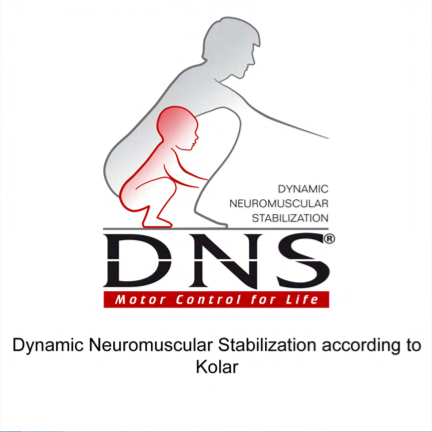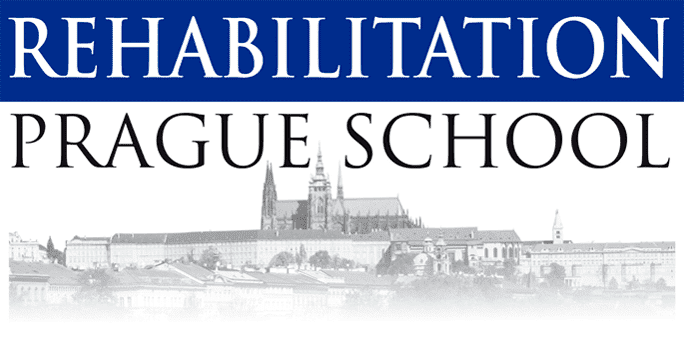The basic premise and progression of DNS
The central nervous system (CNS) establishes programs that control human posture and movement. This ‘motor control’ is largely established during those ever-so-important first few years of life. Based on this understanding, the “Prague School” and the innovators who developed DNS utilize neurodevelopmental ideals to diagnose and treat dysfunction of the locomotor system. In plain English, that means we use the prototypical movement patterns of infants to assess and correct imbalances and errors in the neuromusculoskeletal system in people of all ages. (At least, that is my version of “plain English”.)
The “Prague School” of Rehabilitation and Manual Medicine was established by absolute giants in the 20th Century rehabilitation movement; their history involves key neurologists and physiatrists like Professors’ Vaclav Vojta, Karel Lewit, Vladimir Janda, and Frantisek Vele. Based upon the ground breaking neurodevelopmental and rehabilitation principles described by these mentors, Pavel Kolar has organized the next generation of clinical protocols that are designed to restore and stabilize locomotor function. This approach is known as Dynamic Neuromuscular Stabilization (DNS).
Dynamic Neuromuscular Stabilization (DNS) according to Kolar is a complex therapeutic approach that (in their own words):
- Encompasses the principles of developmental kinesiology during the first year of life;
- Defines posture, breathing patterns, and functional joint centration from this neurodevelopmental perspective; and
- Derives the ideal quality of these functional stereotypes from central (neurological) programs maturing during early postural ontogenesis.
(In my words,) DNS takes the three basic premises listed above and puts them into clinical practice for patients at all stages of life. It is NOT a “technique”. It is an overall strategy designed to better understand the neuro-physiological principles of locomotor system function. Based on an in-depth understanding of these ideals, the DNS practitioner can implement a variety of treatment techniques into a comprehensive, developmentally-sound framework, with better clinical results.
Movement starts with stability. It develops this way as infants under the guidance of in-born reflexes and "programming" and it should automatically be occurring this way for every movement of every day.
For example: The integrated stabilization system of the spine includes the multifidus, deep neck flexors, diaphragm, abdominal wall, and pelvic floor. These muscles should automatically engage synergistically prior to purposeful movement to establish a stable base (or “punctum fixum”). This is known as a Feedforward Mechanism. When this subconscious stabilization occurs, it provides the body with balance, efficiency, and security of the involved joints and tissues. Stabilization of the trunk should occur during any phasic movement, with the stabilizing muscles acting as a functional unit. It is also important for static loading of the spine (as in sitting and standing). Deviations in this subconscious system lead to motor dysfunction.

The brain must be adequately stimulated and conditioned to automatically activate the optimal movement patterns necessary to co-activate stabilizers. During this ideal pattern, the spinal and extremity joints become centrated, the spine becomes axially extended, and intra-abdominal pressure is activated; stability in all body segments is achieved, which is the foundation for healthy movement. This is what we are aiming for with DNS.
In a nutshell, THE GOAL OF DNS is to improve or normalize the quality of:
Postural stabilization patterns,
Respiratory patterns, and
Locomotion patterns.
"Still" better, breath better, move better.
DNS Assessment & Treatment
DNS Assessment is based on a diagnostic comparison of the patient’s stabilizing pattern to the ideal developmental stabilization pattern of a healthy neurotypical infant. Developmental kinesiology defines these ideal patterns used in the treatment of both adults and children. In practice, this includes a standardized set of functional tests in different positions. The goal of the functional tests is to: (1) analyze quality of functional stability, and (2) assist in finding a “key link” of dysfunction. The findings in these tests will directly guide treatment.
When initiating DNS assessment with a patient, this includes a lot of analyzing breathing dynamics; it is basically observing diaphragmatic and stabilization response while breathing in very specific, developmentally-relevant positions.
DNS Treatment is essentially an attempt to restore any identified aberration in the stabilization, breathing, and movement patterns so they function more like the developmental ideal. It is all based on the ontogenetic postural locomotor patterns. The primary goal of treatment is to optimize the distribution of internal forces of muscles that act on each segment of the spine and other joints, therefore enhancing the efficiency of movement.
Actual treatment in office may include whatever tools a particular therapist has in their repertoire. For the typical DNS practitioner, this includes the following progression:
- Manual therapy. This includes soft tissue treatment and spine/rib/extremity joint mobilization, removing barriers to physical movement and priming sensorimotor integration.
- Practitioner-evoked ideal pattern of stabilization. This includes assisted and very specific functional exercises to improve spinal stability by targeting the integrated central stabilizing system as defined by developmental kinesiology. This usually involves the use of Vojta Reflex Locomotion.
- Patient-activated ideal pattern of stabilization. This means that the patient is trained to activate the same quality of stabilization voluntarily under clinician’s supervision.
- Self-treatment homecare exercises & body awareness training. This will start as very simple, somewhat-odd, yet difficult position-specific exercises. Gradually, there will be an integration of ideal patterns into daily activities (including work and sport).
The ultimate goal of care is to teach the brain to maintain central control and stability of the movements restored during therapy. Although initially, these ideal patterns are stimulated by the practitioner (using Reflex Locomotion), as the treatment advances, the movement patterns will fall under the patient’s voluntary control. Through repetition of exercises, the central control establishes an automatic model that becomes a fundamental part of everyday activities. This is really good news for patients and practitioners because it implies that, once engrained, ideal stabilization with movement becomes automatic, subconscious, and “hard-wired”. You do not have to keep doing the same exercises forever to maintain a lasting effect.
References & Resources
Article in IJSPT: CLINICAL COMMENTARY: DYNAMIC NEUROMUSCULAR STABILIZATION & SPORTS REHABILITATION
Kolar, P. et al. (2013) Clinical Rehabilitation.
Liebenson, C. (2007) Rehabilitation of the Spine (2nd ed).
Links to Literature & Research from RPS.
Prague School 16-minute YouTube video on DNS.
Prague School DNS Basic Premise Slide Show
Prague School Developmental Kinesiology Slide Show


